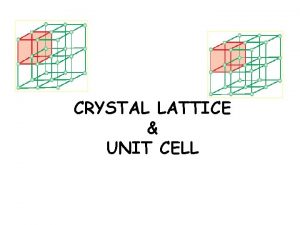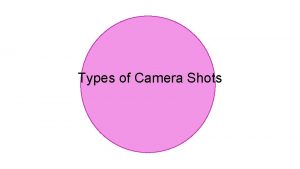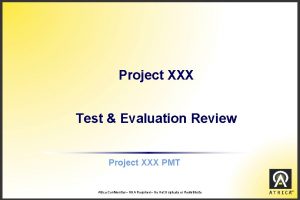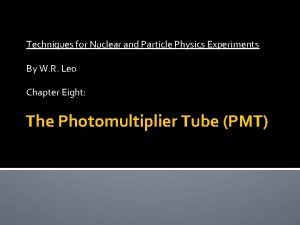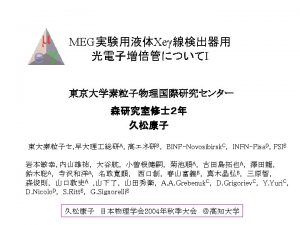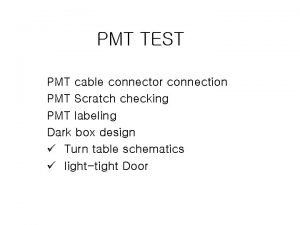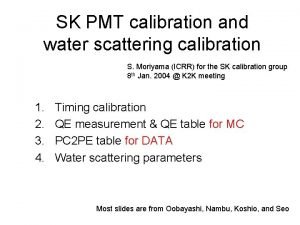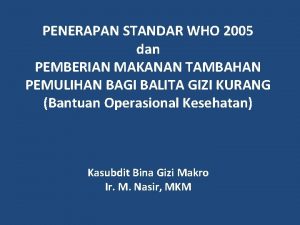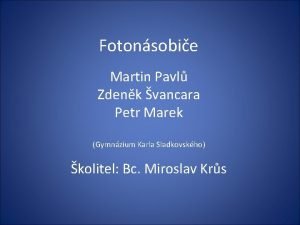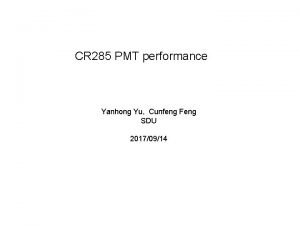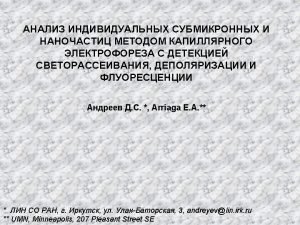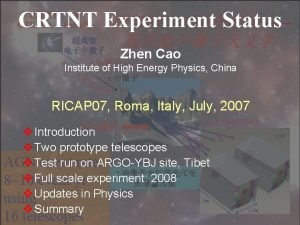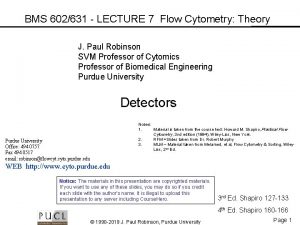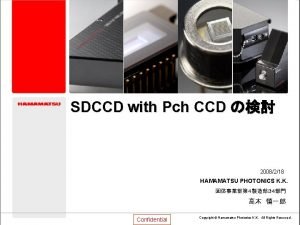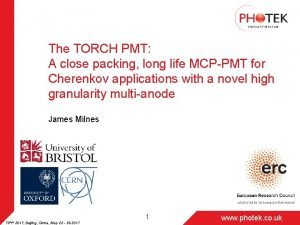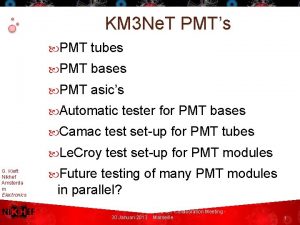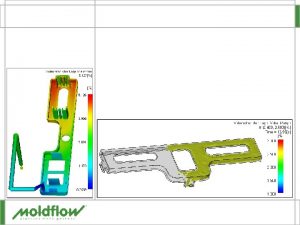The TORCH PMT A close packing multianode long

























- Slides: 25

The TORCH PMT: A close packing, multi-anode, long life MCP -PMT for Cherenkov applications James Milnes International Conference on New Photo-detectors, Moscow 7 July 2015 1 page 1 www. photek. co. uk

Photek MCP-PMTs • Photek currently manufacture the fastest PMTs in the world in “analogue mode”: – Whole pulse is captured by an oscilloscope or digitiser – Applications often “single-shot, high intensity”, e. g. Fusion Research – We have several detectors on the diagnostics at the National Ignition Facility – Fast pulse response ~ 100 ps FWHM – Fast Gating Transition ~ 2 ns International Conference on New Photo-detectors, Moscow 7 July 2015 2 www. photek. co. uk

Photek MCP-PMTs • MCP-PMTs are also the leading detector for time-resolved photon counting • Jitter in photon arrival measurements ~ 30 ps FWHM – Significantly better for multi-photon events • Excellent fit for Cherenkov-based particle detection • Drawbacks: – Detector Lifetime – Most models are round, single anode and not close-packing International Conference on New Photo-detectors, Moscow 7 July 2015 3 www. photek. co. uk

The TORCH PMT • In November 2012 Photek started the 3 -year development of the TORCH (Timing Of internally Reflected CHerenkov photons) PMT • A collaboration with CERN and the Universities of Oxford and Bristol for the LHCb upgrade • Technical aims: – A lifetime of 5 C/cm 2 of accumulated anode charge or better – A multi-anode readout of 8 x 128 pixels • Fine pitch resolution target 0. 41 mm – Close packing on two apposing sides with a fill factor of 88% or better • 53 mm working width within a 60 mm envelope International Conference on New Photo-detectors, Moscow 7 July 2015 4 www. photek. co. uk

TORCH - Motivation • TORCH is an ERC funded R&D project • Proposal to upgrade LHCb Particle ID capabilities in 2 -10 Ge. V/c region International Conference on New Photo-detectors, Moscow 7 July 2015 5 www. photek. co. uk

The TORCH PMT • Three main aims: 1. Lifetime 2. High granularity multi-anode 3. Square International Conference on New Photo-detectors, Moscow 7 July 2015 6 www. photek. co. uk

1. MCP-PMT Lifetime • Standard MCP detectors suffer from sensitivity loss after prolonged exposure: – An MCP has a very large surface area – Prolonged electron bombardment of this surface releases material that is ionised – These ions are drawn back to the photocathode and reduce sensitivity • Previous solutions have involved barrier films to prevent the ions reaching the photocathode – Limited success – Lowers MCP efficiency and overall sensitivity International Conference on New Photo-detectors, Moscow 7 July 2015 7 www. photek. co. uk

1. MCP-PMT Lifetime • Recent technology of ALD (Atomic Layer Deposition) coating on MCP has significantly reduced out-gassing • Two PMT samples produced in 2011: Double-MCP 10 mm diameter working area – One with coated MCPs, One control with standard MCPs • Independently verified by Photek and others: Britting et al (Photo. Det 2012), Conneely et al (VCI 2013) International Conference on New Photo-detectors, Moscow 7 July 2015 8 www. photek. co. uk

1. MCP-PMT Lifetime • ALD coating results in no detectable sensitivity loss after > 5 C/cm 2 • Some gain reduction • 6 test devices produced, 2 successfully life tested at Photek, 1 currently being tested at CERN International Conference on New Photo-detectors, Moscow 7 July 2015 9 www. photek. co. uk

1. MCP-PMT Lifetime • ALD also gives major gain enhancement International Conference on New Photo-detectors, Moscow 7 July 2015 10 www. photek. co. uk

1. MCP-PMT Lifetime • In other respects, coated MCPs behave as normal • Jitter measurement made with 40 ps laser source International Conference on New Photo-detectors, Moscow 7 July 2015 11 www. photek. co. uk

1. MCP-PMT Lifetime • Photek have licensed Arradiance ALD technology for in-house coating of MCP substrates • We have started a KTP project in collaboration with the University of Liverpool ALD research group – Embed ALD process knowledge in Photek – Optimise process to improve MCP collection efficiency International Conference on New Photo-detectors, Moscow 7 July 2015 12 www. photek. co. uk

2. High granularity multi-anode • Traditional multi-anode manufacturing uses multiple pins brazed through a solid ceramic • Prone to leaking, also unrealistic for a 128 x 8 array! • Our aim is to use multilayer ceramic with filled vias • Much smaller pad size allows for finer pitch • The pads on this design are 0. 75 mm wide on a 0. 88 mm pitch Vacuum side International Conference on New Photo-detectors, Moscow 7 July 2015 Air side 13 • Target resolution is 0. 41 mm www. photek. co. uk

2. High granularity multi-anode • How do we obtain position resolution beyond the pitch of the pads? – Deliberately spread the charge footprint – Charge is shared over multiple pads – Charge is measured on each pad – Simple algorithm calculates the interpolated position • Cannot share over too many pads without compromising the occupancy level – Important in a tube designed for high count rates International Conference on New Photo-detectors, Moscow 7 July 2015 14 www. photek. co. uk

Thin insulator between resistive layer and pads 2. High granularity multi-anode • Image Charge technique is recognised way of spreading charge footprint • However, charge would Charge cloud from MCP The signal is A. C. coupled onto buried pads spread too much through 2 mm of ceramic • Solution is to have buried pads: – UK Patent 1510859. 0 • Resistive layer collects the charge By A. C. coupling the signal, the input window can be at 0 V International Conference on New Photo-detectors, Moscow 7 July 2015 VACUUM SIDE 15 AIR SIDE www. photek. co. uk

2. High granularity multi-anode • Seven 32× 32 multi-anode prototypes built with charge sharing anode – In one direction 8 pads ganged together to create 32× 8 layout (1/4 of square tube’s active area) – With charge sharing improve resolution to 64× 8 pixel equivalent (or better) – Use Anisotropic Conductive film to connector detector output to readout PCB International Conference on New Photo-detectors, Moscow 7 July 2015 16 www. photek. co. uk

2. High granularity multi-anode • Test performed on University of Bristol laser Vertical motion stage scanning setup • >15 µm laser spot size • Use a 5 GHz, 40 GS/sec scope to sample output for Pulsed 405 nm four channels • Digitised pulse integrated Readout laser MCP-PMT Horizontal motion stage to measure charge per pad International Conference on New Photo-detectors, Moscow 7 July 2015 17 www. photek. co. uk 1

2. High granularity multi-anode • Charge footprint spread measured on oscilloscope • FWHM ~ 1. 7 mm • Slightly larger than predicted – Modified prototype currently in production International Conference on New Photo-detectors, Moscow 7 July 2015 18 www. photek. co. uk

2. High granularity multi-anode • Applying imaging algorithm on event by event basis, with laser aligned in centre of 4 pixels • 0. 225 mm FWHM derived from pads on a 0. 83 mm pitch • Need to measure with NINO International Conference on New Photo-detectors, Moscow 7 July 2015 19 www. photek. co. uk

2. High granularity multi-anode • Contact made to anodes by Anisotropic Conductive Film (ACF) – Mechanically applied ACF Detector used in circular prototypes – Thermally applied ACF aimed be used in square version ACF PCB – Promising early results with thermal application z y ACF is insulating in x and y but conducting in z x International Conference on New Photo-detectors, Moscow 7 July 2015 20 www. photek. co. uk

2. High granularity multi-anode - readout • NINO ASIC • 32 channel differential amplifier • Convertor (HPTDC) • /discriminator developed at CERN • High Performance Time-to-Digital A programmable TDC developed for ALICE time-of-flight RPCs at the LHC 10 ps RMS jitter on the leading • edge Two modes of 100 ps LSB resolution • >>10 MHz maximum rate with 32 channels, or 24. 4 ps LSB • The time-over-threshold technique resolution with 8 channels • uses the discriminator output pulse Default maximum rate is 2. 5 MHz per width to determine the event channel, can be increased beyond 10 charge MHz using higher logic clock International Conference on New Photo-detectors, Moscow 7 July 2015 21 www. photek. co. uk

3. Square Tube Development • Square tube manufacturing was new to Photek • So far, we have successfully developed methods of – Square body brazing – Square MCP locating – Square photocathode sealing – Square anode sealing • Current status: – Producing leak-tight square test cells International Conference on New Photo-detectors, Moscow 7 July 2015 22 www. photek. co. uk

Summary • TORCH PMT in development at Photek • 3 year development aims to finish in November 2015 • 1 st year task complete: To produce long-life demonstrators • 2 nd year task complete: To produce high-granularity multi-anode demonstrator • Final year task: Fully functioning detector International Conference on New Photo-detectors, Moscow 7 July 2015 23 www. photek. co. uk

With thanks to… The members of the TORCH collaboration at the University of Bristol, CERN and the University of Oxford The TORCH project is funded by an ERC Advanced Grant under the Seventh Framework Programme (FP 7), code ERC-2011 -ADG proposal 299175. International Conference on New Photo-detectors, Moscow 7 July 2015 24 www. photek. co. uk

Thank you for listening International Conference on New Photo-detectors, Moscow 7 July 2015 25 www. photek. co. uk
 Close packing
Close packing Characteristic of solid state
Characteristic of solid state Long and short
Long and short Once upon a time there lived a fox
Once upon a time there lived a fox Từ ngữ thể hiện lòng nhân hậu
Từ ngữ thể hiện lòng nhân hậu Point of view shot example
Point of view shot example Xxxpmt
Xxxpmt Pmt particle physics
Pmt particle physics Pmt
Pmt Suntrust olb mtg pmt
Suntrust olb mtg pmt 7 pmt thema's
7 pmt thema's Pmt cable
Pmt cable Sk pmt
Sk pmt Blooper pmt
Blooper pmt Contoh menu pmt pemulihan
Contoh menu pmt pemulihan Pmt zkratka
Pmt zkratka Pmt function in excel 2007
Pmt function in excel 2007 Pmt
Pmt Electropherogram
Electropherogram Pmt xxx
Pmt xxx Competence motivation theory
Competence motivation theory Pmt protection plan primary life/dis/iu
Pmt protection plan primary life/dis/iu Cao pmt
Cao pmt Apd vs pmt flow cytometry
Apd vs pmt flow cytometry Pmt 0140 team management and leadership exam
Pmt 0140 team management and leadership exam Craig robinson pmt
Craig robinson pmt
